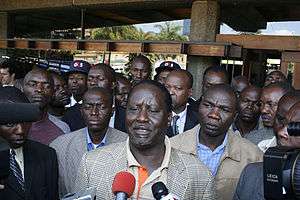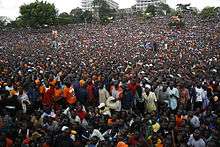Orange Democratic Movement
Orange Democratic Movement | |
|---|---|
 | |
| Abbreviation | ODM |
| Leader | Raila Odinga |
| Chairman | John Mbadi |
| Secretary-General | Dr. Agnes Zani (Ag.) |
| Spokesperson | Philip Etale |
| Founder | Mugambi Imanyara |
| Founded | 2005 |
| Headquarters | Nairobi, Kenya |
| Newspaper | The kenyan weekly |
| Youth wing | ODM Youth League (OYL) |
| Women's wing | ODM Women League (WL) |
| Veteran's wing | ODM Veterans |
| Ideology |
Liberal democracy[1] Social democracy[2] |
| Political position | Centre-left[1] |
| National affiliation | CORD |
| International affiliation | Liberal International (observer)[3] |
| African affiliation | Africa Liberal Network |
| Colours | orange |
| Slogan |
Chungwa Moja, Maisha Bora! One Orange, Better Life! |
| National Assembly |
96 / 349 |
| Senate |
17 / 67 |
| EALA |
5 / 9 |
| Pan-African Parliament |
2 / 5 |
| Governors |
16 / 47 |
| Members of County Assemblies |
578 / 1,450 |
| Website | |
|
www | |
The Orange Democratic Movement is a political party in Kenya. It is the successor of a former grassroots people's movement which was formed in the 2005 Kenyan constitutional referendum. The erstwhile single party which separated in August 2007 into two. The two parties are the Orange Democratic Movement Party of Kenya (usually known simply as ODM), and the Wiper Democratic Movement – Kenya (formerly Orange Democratic Movement – Kenya; known as ODM–Kenya).
The name "orange" originates from the ballot cards in the referendum, in which a 'Yes' vote was represented by the banana and a 'No' vote was the orange. Thus the parties claim successorship to those who did not support the referendum at the time. The original linchpins of the ODM were Uhuru Kenyatta's KANU party and Raila Odinga's LDP. However, KANU has since pulled out, and the two groupings are headed by Raila Odinga (ODM) and Kalonzo Musyoka (ODM–Kenya).
Constitutional referendum
The 'No' vote, which the ODM campaigned for, won out with 58.12% of Kenyans voting down the proposed constitution, granting victory to the Orange. Following the rejection of the constitution, President Mwai Kibaki proceeded to dismiss his entire cabinet. The response of the ODM was to say that this was a step in the right direction, but called for immediate general elections for the entire Kenyan government, claiming that the Kibaki regime had lost its mandate as a result of the referendum which it vigorously campaigned in favour of.
Kibaki's government has resisted this and elections were not held until the last week of Kibaki's five-year constitutionally-mandated tenure. However, the ODM has emerged as a major opposition party along with KANU, and has organised a number of rallies throughout the country asking for elections and a new constitution amongst other demands. Also, the ODM has protested Kibaki's new cabinet. Liberal Democratic Party (LDP), which opposed the referendum, was dropped out of the cabinet.
2007 elections

After the 2002 elections KANU was beaten into opposition, while LDP was a partner in the ruling NARC coalition, until it was kicked out after the 2005 referendum. LDP had supported no vote at the referendum, thus being against president Kibaki. Following their united stand in the referendum debate and responding to a threat by a newly formed Narc-Kenya party, the leaders of KANU, LDP and some smaller parties decided to team up for the upcoming 2007 Kenya general elections, forming the Orange Democratic Movement, which was named after the symbol of an orange used to represent "No" in the referendum. However, opportunist lawyer Mugambi Imanyara managed to register ODM as a party before the coalition did, forcing them instead to use the ODM-Kenya banner.[4]
As 2007 progressed the coalition proved unstable, with various factions defecting. Uhuru Kenyatta's KANU were the first, pulling out in July 2007 and endorsing President Kibaki's re-election, although some individual KANU politicians stayed in ODM. Then, due to internal rivalry between Kalonzo Musyoka and Raila Odinga, ODM split into two factions in mid-August 2007.[5][6] Raila's group, which also included Musalia Mudavadi, William Ruto, Joseph Nyagah and Najib Balala defected from ODM Kenya and took over the ODM party registered by Mugambi Imanyara, while Kalonzo's group, led by himself and Dr. Julia Ojiambo remained in the original ODM-Kenya.
The two factions held their elections for presidential candidate on consecutive days at the Kasarani sports complex in Nairobi. On 31 August 2007, Kalonzo Musyoka defeated Julia Ojiambo for the ODM–Kenya ticket, then on 1 September Raila Odinga defeated Ruto, Mudavadi, Balala and Nyagah. There were allegations that some delegates attended and voted in the nominations of both parties bringing to light the problem of ambiguous political party membership that is in Kenya.
General election

Raila and Kalonzo then faced president Kibaki in the general election. Kibaki was declared winner of the elections in circumstances that were described as "questionable" by various observers. The manner in which elections were conducted bordered on poll rigging.
The now disbanded Electoral Commission of Kenya (ECK) chairman, Samuel Kivuitu could not explain why votes from nearby constituencies had not reached tallying centre in Nairobi while those from far-flung zones of the country were tallied on time. Some poll results were erased by white out and re-written in favour of the then PNU presidential candidate. The maths failed to add up as many polling stations in perceived PNU zones had more votes cast than the number of registered voters.
ODM disputed the results. Violence erupted in the country with ODM supporters in Kibera, Naivasha and Nakuru being targeted for attack by Mungiki terror gangs, allegedly backed by police. PNU supports were also targeted for attack by ODM supporters. People of ethnic Luo were killed by bullets in Kisumu, Kibera and Nakuru in large numbers while people of ethnic Kikuyu were killed in Rift Valley in large numbers.
ODM ended up winning the majority seats of in parliament. It became the largest party in parliament after the December 2007 elections with 99 members of parliament and went ahead to win 3 out of five by-elections in early 2008. However it seems that the jinx of losing members of parliament still haunts the party since no sooner had by-elections been conducted in the constituencies of two ODM MPs who were killed at the beginning of the year than two more MPs died in an aircraft crash. Some ODM MP's whose elections were contested in court have lost their seats and more elections petitions are still going on.
Political Parties Act and Party Elections
Following the passing of the political parties act. ODM, held its internal elections in late December 2008 with Prime Minister Raila Odinga emerging as party leader, and Industrialisation Minister Henry Kosgey as party chairman. However, due to agitation over regional and gender representation, some party posts had to be created on the day.[7] Raila has since fallen out with William Ruto Ababu Namwamba and Najib Balala, three key members of the party, as well as his longtime deputy Musalia Mudavadi.
2013 General Elections
In the lead up to the 2013 General elections, ODM entered a coalition with FORD-Kenya and Wiper Democratic Movement, to support a single presidential candidate, known as the Coalition for Reforms and Democracy[8]

Controversies
In October 31 2016, ODM Ejected a renown member who once vied to be its chairman Ababu Namwamba over what was believed to be an attempt to consolidate the support behind the current chairman's bid for presidency. Ababu Namwamba though an ODM member felt that Mr Odinga (who had vied for presidency and twice), was no longer capable of convincing the masses to vote for him.
References
- 1 2 Kenya country update - European Forum
- ↑ Kisika, Samuel (2014-03-31). "ODM MPs to amend bill seeking to reduce school drop-out cases". news24.com. Retrieved 2014-06-09.
- ↑ http://www.liberal-international.org/site/Liberal_International_welcomes_new_members.html
- ↑ "Orange team up in arms over party’s registration" The East African Standard, 29 December 2005
- ↑ "Opposition in Kenya splits in two", BBC News, 15 August 2007
- ↑ "Final fallout" The east African Standard, 15 August 2007
- ↑ ODM shortchanged us, says South Rift leaders http://www.eastandard.net/InsidePage.php?id=1144002781&cid=159
- ↑ Raila, Kalonzo seal deal as Mudavadi joins Uhuru, Ruto http://www.standardmedia.co.ke/?articleID=2000072150&story_title=Kenya-Raila,-Kalonzo-seal-deal-as-Mudavadi-joins-Uhuru,-Ruto
External links
- ODM leader's personal site
- ODM Official website
- ODM Official Community Portal
- ODM–Kenya – old website not updated after ODM-Kenya party split into two – outdated
- ODM 2007 Manifesto
- ODM 2007 Parliamentary Candidates